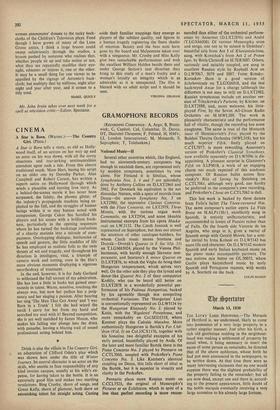GRAMOPHONE RECORDS
(RECORDING COMPANIES: A, Argo; B. Bruns- wick; C, Capitol; Col, Columbia; D, Decca; DT, Ducretet-Thomson; F, Felsted; H, HMV; LI, London International; M, Monarch; S, Supraphon; T, Telefunken.)
National Music--II
Several other countries which, like England, had no nineteenth-century composers big enough to establish them, are represented only by modern composers, sometimes by one alone. For Finland it is Sibelius, whose Symphonies Nos. 3, 4 and 7 are splendidly done by Anthony Collins on DIXT2960 and 2962. For Denmark his equivalent is the not dissimilar Nielsen, with a spate of records from Decca—the uneven Symphony No. 5 on LXT2980, the impressive Clarinet Concerto, with the Flute Concerto, on LXT2979, Three Motets, with the curious organ work Common°, on LXT2934, and some likeable instrumental excerpts from his opera Maska- rade on LW.5132. The Czech Janacek is well represented on Supraphon, but does not attract the attention of other catalogue-builders, for whom Czech music means Smetana and Dvorek—Dvorak's Quartet in E fiat (Op. 51) on T.LGM65024, played by the Vienna Phil- harmonic, with hardly enough Slavonic tem- perament, and Smetana's E minor Quartet on D.LXT2876, to which the V6ghs do bring their Hungarian temperament, which serves very well. On the other side they play the lyrical and dance-like Quartet No. 2 of their compatriot Kodaly, who can be heard still better on D.LXT2878 in a wonderfully powerful per- formance of his Psalmus Hun garicus, backed by his agreeable though less compelling orchestral Variations. The 'Hungarian' Liszt is conventionally represented on D.LW5134 by the Hungarian Rhapsody No. 2, played by Katin, with the Rigoletto' Paraphrase, and more remarkably on Col.SED5519, where Kentner plays the Csardds Macabre. More authentically Hungarian is Bartek's For Chil- dren (Vol. 1) on Co1.33CX 1176, together with his Sonatina, two delightful examples of his early period, beautifully played by Anda. Of the later and more familiar Bart6k there is the Piano Concerto No. 3 played by Pennario on C.CTL7060, coupled with Prokofiev's Piano Concerto No. 3. Like Katchen's identical coupling on Decca, this falls short of ideal in the Bartok, but it is superior in vivacity and clarity in the Prokoflev.
Pcnnario plays more Russian music on C.CCL7525, the original of Mussorgsky's Pictures at an Exhibition, which in spite of a less than perfect recording is more recom-
mended than either of the orchestral perform-
ances by Ansermet (D.LXT2896) and Andre (T.LGX66008). Of various Mussorgsky arias and songs, one not to be missed is -Dositheu'f beautiful aria from Act 5 of Khovantshchina, sung, with Kontchak's from Act 2 of Prince Igor, by Boris Christen on H.7ER5007. Others, variously and suitably coupled, are sung in excellent Russian style by Raphael Arie on D.LW5067, 5079 and 5087. From Rimsk y- Korsakov there is a good version of Scheherazade on T.LGX66018, and the less hackneyed Antar for a change (although the difference is not easy to tell) on D.LXT2982. Russian symphonies include yet another ver- sion of Tchaikovsky's Pathetic, by Kleiber. on D.LXT2888, and, more welcome, his little- played First, by the Soviet All-Union Radio Orchestra on M.MWL309. The work is pleasantly characteristic and the performance full of vitality, though the recording has some roughness. The same is true of the Monarch issue of Shostakovich's First, played by the Bolshoi Theatre Orchestra (MWL318), but his much superior Fifth, finely played on C.CTL7077, is more rewarding. Ansermet's version of Prokofiev's Classical Symphony. now available separately on D LW5096 is dis- appointing. A pleasant surprise is Glazunov's Fifth on S.LPM18. a work of an engaging charm not much expected of this academic composer. Of Russian ballet scores Stra- vinsky's Rite of Spring by Steinberg on C.CTL7061, although very good, can hardly be preferred to the composer's own recording, and Prokofiev's Chow on C.CTL7062 is dull.
This last work is backed by three dances from Falla's ballet The Three-cornered Hat. The same composer's earlier opera La Vida Breve on H.ALPI 150/1, excellently sung in Spanish, is entirely unnaracteristic, and recommended to lovers of Puccini rather than of Falla. On the fourth side Victoria de los Angeles, who sings in it, gives a recital of Spanish songs with Gerald Moore, but a simi- lar recital by Irma Kolassi on D.LW5143 has more life and character. On D.LW5142 modern Spanish and early Italian keyboard music on the piano make incompatible partners. The two nations mix better on OL.50032, where Gerlin plays harpsichord music by early Spanish and Portuguese masters, with works by A. Scarlatti on the back.
COLIN MASON










































 Previous page
Previous page